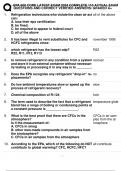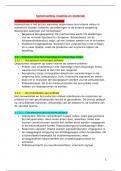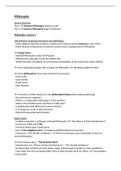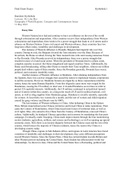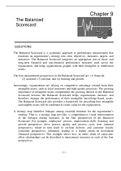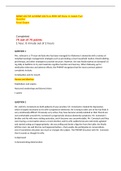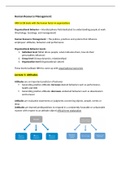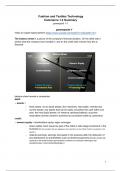MODULE 1: PSYCHIATRIC DISORDERS
Lecture 1 + 2: Etiology of mental traits and conditions
Behavior traits: impulsivity, mood, social behavior, stress-sensitivity, resilience and vulnerability.
- Each trait exists along a spectrum
o Example: Impulsivity (extremely thoughtful, difficulties decision taking – extremely
impulsive)
- What creates a trait? Is there a border between normal and abnormal behavior?
- Other traits: iq, extraversion, blood pressure
- Disorders: diabetes, obesities, autism (?), depression, schizophrenia
What factors can contribute to traits / (mental) characteristics and brain disorders
- Genetics
- Environmental factors
o Stress, infection, food, pregnancy, alcohol, trauma, family situation, etc.
Nature – nurture discussion:
- Past: tendency to explain disease via nurture concept.
o Autism = refrigerator mother
o Homosexual orientation= overly present mother
- Later: role biological factors more clear (nature)
- Hard reductionism: all psychiatric illness is best explained solely in terms of molecular
neuroscience
- Etiological models for psychiatric disease need to be pluralistic (= trueth is more than reality,
with a multiplicity of principles) or multilevel
- Best understood from biological, psychological and sociocultural, economic perspectives
- Break down dichotomy between nature-nurture, but view brain as in constant interaction
with environment, society and culture via plasticity.
Most brain disorders are complex, multifactorial disoders
- Both genetic and environmental factors involved in etiology.
- Often complex interactions and causal loops, Complex puzzle
- Genes and environmental factors
- How can environmental factors exert their influence?
o Altered expression via
▪ Stress system
▪ Epigenetics
- Interactions gene-environment
Genes
- From twin + adoption studies: several behavioral traits and psychiatric diseases moderate /
high heritability
- Heritability: proportion of variance in symptoms (of a certain condition) that is explained by
the variance in genetic factors
o Major depression 40-50%
o ADHD: 75%
2
, o Autism, bipolar disorder, schizophrenia around 80%
o NOT: when your parents have ADHD, you have 75% change getting it. trueth: you can
explain a trait (impulsivity) 75% by the genetics.
- In post – humane genome project era
o Expectation: easy to find risk genes
o Contrary: it was very difficult to identify the risk genes; ‘Missing heritability’
o Model of single / few risk genes = overly simplistic paradigm. (genetic risk is not
really a thing. It increases the risk only by a tiny amount. It is difficult to spot this).
Genes and psychiatry
- Classic theory: Single abnormal gene → abnormal gene product → neuronal malfunction →
mental illness
o Single abnormal gene is not sufficient to cause mental conditions
o What is pathway from gene to mental conditions?
- New explanations, new hypotheses, new models for pathway ‘genotype to phenotype’.
o 1. ‘Complex genetics’ or ‘diathesis-stress model’ (explained in lecture etiology)
o 2. ‘Differential susceptibly to environment hypothesis’ (explained in lecture
neurobiology of resilience)
o 3. ‘balancing selection hypothesis’ (explained in lecture mental illness & creativity)
- new hypotheses and new models are complex
- new ways of doing research and unravel these pathways from genotype to phenotype:
‘endophenotype approach’
1. stress – diathesis (=risk) model : predisposition (genetic) + environmental stress → disease
new paradigm:
- hypothesis: mental conditions are caused by multiple small contributions from several genes,
all interacting with environmental stressors.
- ‘Complex genetics’
o Complex set of risk factors that bias person toward condition/illness but do not cause
it (inherits risk not disease). it is about probability. Every risk factor is tiny.
o Reachting tipping point: high probability developing condition/disorder. (critical
point in an evolving situation that leads to a new and irreversible development)
o Concept also applies to hypertension, obesity, diabetes, etc.
Endophenotype approach: from genotype to phenotype
- path from gene → mental illness
- new ways of doing research and unravel’ these pathways from ‘genotype to phenotype’:
endophenotype approach
- pathway genotype to phenotype is much more complex!
- solution: important intermediaries between gene (genotype) and
disease/behavior(phenotype)
- endophenotypes:
o measurable, inheritable and closely linked to disease condition
o more precisely measurable than disease/condition
o two types:
▪ biological endophenotypes (more close to genotype site)
▪ symptom/system endophenotypes (more close to the phenotype site)
3
,biological endophenotype: measurable biological phenomena
o electrophysiological response to startle
o neuroimaging response to information processing
o activation of certain brain circuit
symptom/system endophenotypes: single symptoms associated with mental disease/condition:
o insomnia
o executive dysfunction
o hallucinations
o poor fear conditioning
o anhedonia (easily with a questionnaire)
genes and psychiatry
- gene → molecules → circuits → information processing (biological phenotype) → single
symptom (system endophenotype) → full syndrome or mental condition/disorder
o closer to the gene on pathway → more readily linked to gene (so the link gene to
endophenotype is easier than to the condition / disease)
o genes only loosely linked to psychiatric conditions/disorders, therefore hard to
identify
psychopathology and brain circuits
- etiology of psychiatric conditions is moving beyond receptors, enzymes and other molecules
as causes. (depression is often explained by to low numbers of serotonin, this is not etiology
good explained).
- New paradigm: psychiatric symptoms are increasingly linked to malfunctioning specific brain
circuits
- Genes + environmental risk factors conspire to produce inefficient information processing in
neuronal circuitry
- Brain imaging → focus on brain circuits
Why are subtle molecular abnormalities not more ‘penetrant ‘at behavioral level?
- Multiple genes complementary / redundant effects ‘healthy compensatory backup system’.
- Risk genes are not necessary sufficient to cause mental conditions / disorders
- Combination with environmental risk factors (stress, life events, biological stressors such as
viruses, toxins…)!!!
Socio-ecological framework: no single factor can explain
- There is a dynamic interplay of multiple risk and protective factors.
o Risk and protective factors are along a social ecology continuum: (small to big)
▪ Individual (also genes belong to this) – Relationship - Cultural /
environmental
o Environmental:
▪ Pre/peri natal risk factors: maternal stress during pregnancy, maternal
nutritional deficiency, maternal use of tobacco / alcohol / drugs /
medication.
▪ Birth complications
▪ Perinatal nutrition deficiency, maternal separation
4
, ▪ Abuse,(sexual / emotional / physical) , neglect, poor parental care
▪ Infections, toxins, brain trauma, drugs use
▪ Stressful life events
▪ Low SES, poverty, community violence
▪ Mental health care & health care policy (assessment, stigmatization of
mental health problems)
▪ Minority group position, cultural factors, religious factors
HOW can environmental factors exert their influence?
- Altered gene expression via (two pathways)
o stress system
o epigenetics
stress system:
every cell in the body has cortisol receptors.
Cortisol is often in a negative context, but it
is an adaptive response, it is not a bad thing.
It increases hart rate, blood pressure, and
helps to concentrate. It can have negative
effects, for example it is toxic for the brain. It
has a negative feedback loop.
the brain has specific cortisol receptors. The
receptor is a protein. The amount of brain
cortisol receptors. A healthy stress system, a
healthy apa axis, is a system with a plenty Figure 1
of cortisol receptors in the brain. This is the
only way a negative feedback can happen. Negative feedback: it inhibits its
own expression. When there is to little cortisol brain receptors, it is not able
to shut down the system.
HPA-axis (hypothalamic-pituitary-adrenal)
- stress → hormone cortisol
- cortisol important in defense response: protective + promote
adaptation
- cortisol binds to glucocorticoid receptor (GR) in body
- GR acts as transcription factor and can alter gene expression
- GR also in several brain areas
- GR in hypothalamus, hypophysis and hippocampus: negative
feedback loop → shut down CRF release Figure 2, normal situation of the negative
Figure 2 loop In brain. Cortisol binding →
feedback
Sustained high levels of cortisol → harmful → hypertension, release less crh, acth, enz. And in the and
cortisol. Also look at the places were the
immunosuppression, cardiovascular disease, structural effects hippocampus receptors are.
+ amygdala, increased chance psychopathology
- Early life stress ( year 1 and 2) → life long overacting HPA-axis (eg. Less GR=less negative
feedback to shut system down
- Hope: evidence that prenatal stress can be moderated by quality of post natal care!
5
Lecture 1 + 2: Etiology of mental traits and conditions
Behavior traits: impulsivity, mood, social behavior, stress-sensitivity, resilience and vulnerability.
- Each trait exists along a spectrum
o Example: Impulsivity (extremely thoughtful, difficulties decision taking – extremely
impulsive)
- What creates a trait? Is there a border between normal and abnormal behavior?
- Other traits: iq, extraversion, blood pressure
- Disorders: diabetes, obesities, autism (?), depression, schizophrenia
What factors can contribute to traits / (mental) characteristics and brain disorders
- Genetics
- Environmental factors
o Stress, infection, food, pregnancy, alcohol, trauma, family situation, etc.
Nature – nurture discussion:
- Past: tendency to explain disease via nurture concept.
o Autism = refrigerator mother
o Homosexual orientation= overly present mother
- Later: role biological factors more clear (nature)
- Hard reductionism: all psychiatric illness is best explained solely in terms of molecular
neuroscience
- Etiological models for psychiatric disease need to be pluralistic (= trueth is more than reality,
with a multiplicity of principles) or multilevel
- Best understood from biological, psychological and sociocultural, economic perspectives
- Break down dichotomy between nature-nurture, but view brain as in constant interaction
with environment, society and culture via plasticity.
Most brain disorders are complex, multifactorial disoders
- Both genetic and environmental factors involved in etiology.
- Often complex interactions and causal loops, Complex puzzle
- Genes and environmental factors
- How can environmental factors exert their influence?
o Altered expression via
▪ Stress system
▪ Epigenetics
- Interactions gene-environment
Genes
- From twin + adoption studies: several behavioral traits and psychiatric diseases moderate /
high heritability
- Heritability: proportion of variance in symptoms (of a certain condition) that is explained by
the variance in genetic factors
o Major depression 40-50%
o ADHD: 75%
2
, o Autism, bipolar disorder, schizophrenia around 80%
o NOT: when your parents have ADHD, you have 75% change getting it. trueth: you can
explain a trait (impulsivity) 75% by the genetics.
- In post – humane genome project era
o Expectation: easy to find risk genes
o Contrary: it was very difficult to identify the risk genes; ‘Missing heritability’
o Model of single / few risk genes = overly simplistic paradigm. (genetic risk is not
really a thing. It increases the risk only by a tiny amount. It is difficult to spot this).
Genes and psychiatry
- Classic theory: Single abnormal gene → abnormal gene product → neuronal malfunction →
mental illness
o Single abnormal gene is not sufficient to cause mental conditions
o What is pathway from gene to mental conditions?
- New explanations, new hypotheses, new models for pathway ‘genotype to phenotype’.
o 1. ‘Complex genetics’ or ‘diathesis-stress model’ (explained in lecture etiology)
o 2. ‘Differential susceptibly to environment hypothesis’ (explained in lecture
neurobiology of resilience)
o 3. ‘balancing selection hypothesis’ (explained in lecture mental illness & creativity)
- new hypotheses and new models are complex
- new ways of doing research and unravel these pathways from genotype to phenotype:
‘endophenotype approach’
1. stress – diathesis (=risk) model : predisposition (genetic) + environmental stress → disease
new paradigm:
- hypothesis: mental conditions are caused by multiple small contributions from several genes,
all interacting with environmental stressors.
- ‘Complex genetics’
o Complex set of risk factors that bias person toward condition/illness but do not cause
it (inherits risk not disease). it is about probability. Every risk factor is tiny.
o Reachting tipping point: high probability developing condition/disorder. (critical
point in an evolving situation that leads to a new and irreversible development)
o Concept also applies to hypertension, obesity, diabetes, etc.
Endophenotype approach: from genotype to phenotype
- path from gene → mental illness
- new ways of doing research and unravel’ these pathways from ‘genotype to phenotype’:
endophenotype approach
- pathway genotype to phenotype is much more complex!
- solution: important intermediaries between gene (genotype) and
disease/behavior(phenotype)
- endophenotypes:
o measurable, inheritable and closely linked to disease condition
o more precisely measurable than disease/condition
o two types:
▪ biological endophenotypes (more close to genotype site)
▪ symptom/system endophenotypes (more close to the phenotype site)
3
,biological endophenotype: measurable biological phenomena
o electrophysiological response to startle
o neuroimaging response to information processing
o activation of certain brain circuit
symptom/system endophenotypes: single symptoms associated with mental disease/condition:
o insomnia
o executive dysfunction
o hallucinations
o poor fear conditioning
o anhedonia (easily with a questionnaire)
genes and psychiatry
- gene → molecules → circuits → information processing (biological phenotype) → single
symptom (system endophenotype) → full syndrome or mental condition/disorder
o closer to the gene on pathway → more readily linked to gene (so the link gene to
endophenotype is easier than to the condition / disease)
o genes only loosely linked to psychiatric conditions/disorders, therefore hard to
identify
psychopathology and brain circuits
- etiology of psychiatric conditions is moving beyond receptors, enzymes and other molecules
as causes. (depression is often explained by to low numbers of serotonin, this is not etiology
good explained).
- New paradigm: psychiatric symptoms are increasingly linked to malfunctioning specific brain
circuits
- Genes + environmental risk factors conspire to produce inefficient information processing in
neuronal circuitry
- Brain imaging → focus on brain circuits
Why are subtle molecular abnormalities not more ‘penetrant ‘at behavioral level?
- Multiple genes complementary / redundant effects ‘healthy compensatory backup system’.
- Risk genes are not necessary sufficient to cause mental conditions / disorders
- Combination with environmental risk factors (stress, life events, biological stressors such as
viruses, toxins…)!!!
Socio-ecological framework: no single factor can explain
- There is a dynamic interplay of multiple risk and protective factors.
o Risk and protective factors are along a social ecology continuum: (small to big)
▪ Individual (also genes belong to this) – Relationship - Cultural /
environmental
o Environmental:
▪ Pre/peri natal risk factors: maternal stress during pregnancy, maternal
nutritional deficiency, maternal use of tobacco / alcohol / drugs /
medication.
▪ Birth complications
▪ Perinatal nutrition deficiency, maternal separation
4
, ▪ Abuse,(sexual / emotional / physical) , neglect, poor parental care
▪ Infections, toxins, brain trauma, drugs use
▪ Stressful life events
▪ Low SES, poverty, community violence
▪ Mental health care & health care policy (assessment, stigmatization of
mental health problems)
▪ Minority group position, cultural factors, religious factors
HOW can environmental factors exert their influence?
- Altered gene expression via (two pathways)
o stress system
o epigenetics
stress system:
every cell in the body has cortisol receptors.
Cortisol is often in a negative context, but it
is an adaptive response, it is not a bad thing.
It increases hart rate, blood pressure, and
helps to concentrate. It can have negative
effects, for example it is toxic for the brain. It
has a negative feedback loop.
the brain has specific cortisol receptors. The
receptor is a protein. The amount of brain
cortisol receptors. A healthy stress system, a
healthy apa axis, is a system with a plenty Figure 1
of cortisol receptors in the brain. This is the
only way a negative feedback can happen. Negative feedback: it inhibits its
own expression. When there is to little cortisol brain receptors, it is not able
to shut down the system.
HPA-axis (hypothalamic-pituitary-adrenal)
- stress → hormone cortisol
- cortisol important in defense response: protective + promote
adaptation
- cortisol binds to glucocorticoid receptor (GR) in body
- GR acts as transcription factor and can alter gene expression
- GR also in several brain areas
- GR in hypothalamus, hypophysis and hippocampus: negative
feedback loop → shut down CRF release Figure 2, normal situation of the negative
Figure 2 loop In brain. Cortisol binding →
feedback
Sustained high levels of cortisol → harmful → hypertension, release less crh, acth, enz. And in the and
cortisol. Also look at the places were the
immunosuppression, cardiovascular disease, structural effects hippocampus receptors are.
+ amygdala, increased chance psychopathology
- Early life stress ( year 1 and 2) → life long overacting HPA-axis (eg. Less GR=less negative
feedback to shut system down
- Hope: evidence that prenatal stress can be moderated by quality of post natal care!
5


